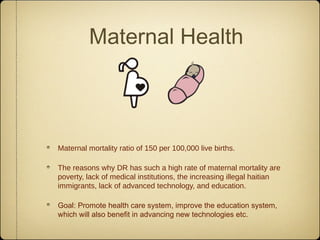Millenium Development Goal in Dominican Republic
- 1. Millennium Development Goals In the Dominican Republic. . .
- 2. Gender Inequality •6.4% of women out of the whole population suffer sexual violence. •Extreme forms of violence towards women are common in rural areas. •Women present in 20% of parliamentarians. •Afro-descendent and indigenous women are considered the lowest, discriminated more than anyone. •Women’s basic duties involve shopping, cooking, caring for disabled persons, laundry and other clothing care, childcare, food preparation and house cleaning. •Women receive a smaller portion of collected benefits from retirement or other pensions than men. •Education wise, 100% rate of primary-school completion among both girls and boys, as well as equal access to secondary and tertiary education for young people of both sexes.
- 3. Universal Education •Less than 40% of the population has completed primary education. •Children from large families do less well in school due to poverty, econometric issues, etc. •There is a need to further education to provide the skills required by the work environment. •The percentage of young women (15-24) not currently in school who abandoned their education because of early pregnancy, 5% in the Dominican Republic (1996).
- 4. Child Health • Access to care, maternal child care including nutrition, general hygiene, and the prevention of STI, including HIV/AIDS. • Teen pregnancy is a major issue in the Dominican Republic, where 20.6 per cent of teens (15-19) are currently pregnant or already mothers. • The 2007 DHS indicates that 61 percent of child mortality occurs during the neonatal period13; therefore, focusing on the critical period before and after delivery is crucial for the survival of the child.
- 5. Global Partnership Free Trade System between the United States & the Dominican Republic Major transit hub for drug traffickers in South America
- 6. End Poverty and Hunger 20% of the Dominican population lives without electricity, (equivalent to 342,000 families) 27% of a total 6,810,000 Dominicans who suffered from malnutrition in 1990 A study found that poverty affects 31.6% of the population.
- 7. Environmental Sustainability 235,000 slum dwellers face with lack of fresh water. Provinces and towns with the highest rates of population growth and other urban zones with slum dwellings. Towns and smaller population centers linked to strategic sectors: tourist resorts, free trade zones, or communication infrastructures including seaports and airports. Towns linked to farming agriculture—sugar cane, coffee, and rice producing areas—or sustainable economic and environmental resources—organic agriculture. Goal: Safe drinking water and proper sanitations.
- 8. Maternal Health Maternal mortality ratio of 150 per 100,000 live births. The reasons why DR has such a high rate of maternal mortality are poverty, lack of medical institutions, the increasing illegal haitian immigrants, lack of advanced technology, and education. Goal: Promote health care system, improve the education system, which will also benefit in advancing new technologies etc.
- 9. Combat HIV/AIDS The rate of HIV infections in young women are rapidly increasing. About 20,000 people have died from AIDS in the past decade. Lack of sufficient medical resources and lack of proper education, play crucial role in the HIV/AIDS objective. 1.7% of the population, about 88,000 people have been infected. Goal: Educate the citizens about safe sex & opening more hospitals, etc.
- 10. Current News For each MDGs. . . For each MDGs. . . Gender Inequality: News Universal Education: News Child Health: News Global Partnership: News End Poverty & Hunger: News Environmental Sustainability: News Maternal Health: News Combat HIV/AIDS: News









